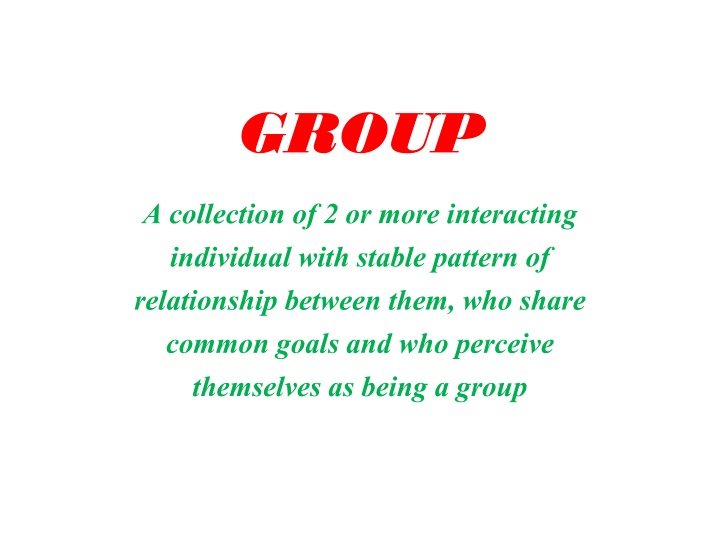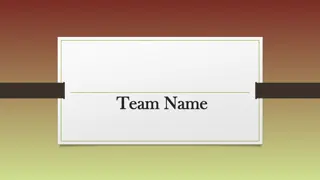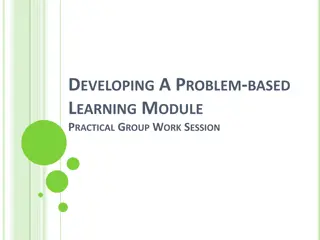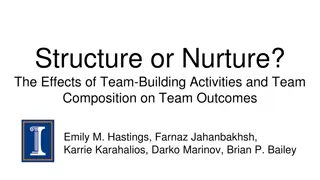
Groups and Teams in Collaboration Environments
Explore the concept of groups and teams, their dynamics, types, cohesiveness, and differences. Discover how collaboration within groups and teams can enhance productivity and achieve common goals effectively.
Download Presentation

Please find below an Image/Link to download the presentation.
The content on the website is provided AS IS for your information and personal use only. It may not be sold, licensed, or shared on other websites without obtaining consent from the author. If you encounter any issues during the download, it is possible that the publisher has removed the file from their server.
You are allowed to download the files provided on this website for personal or commercial use, subject to the condition that they are used lawfully. All files are the property of their respective owners.
The content on the website is provided AS IS for your information and personal use only. It may not be sold, licensed, or shared on other websites without obtaining consent from the author.
E N D
Presentation Transcript
GROUP A collection of 2 or more interacting individual with stable pattern of relationship between them, who share common goals and who perceive themselves as being a group
Features It is the collection of two or more people. They should be in a stable pattern of relationship among them. They should have common interest and shared common goal. They should aware of each other. They should see themselves as members of group.
Types Types of Group of Group (formal) INGROUP & OUTGROUP STANDING TASK GROUP & TASK GROUP FORMAL GROUP & INFORMAL GROUP GROUP (informal) INTEREST GROUP, FRIENDSHIP GROUP & REFERENCE GROUP CLOSED GROUP & OPENED GROUP
GROUP COHESIVENESS It refers to the closeness and attraction of group members towards each other and also towards the group. It is the bonding between the group members and towards the group.
Group dynamic/ group Group dynamic/ group effectiveness effectiveness Dynamic means FORCE Group dynamic deals with the attitude and behavioral pattern of group members. study of forces within a group which bind the group
TEAM Team is a collection of small number of people with complementary skills who are committed to a common purpose, goal and they whole themselves mutually accountable.
Features of Team Small collection of people Complimentary skill Mutually accountable Flexible and responsible to change Common goal.
Difference between GROUP and TEAM Difference between GROUP and TEAM GROUP TEAM In group, performance are typically depends on work of individual member. Performance depends on both individual contribution and collective effort of team member Members of group usually don t take responsibility for any result other than their own. Team focus on both individual and mutual accountability. Group members share a common goal. Team members share a common commitment to achieve the common goal. Groups have to work according to the demand and direction of management. In team, once management fixes the goals for the team. Team gets full freedom and flexibility to do their job with no further interference from management. In team members they have complementary skill In group members have diverse skills
DIFFERENCE BETWEEN GROUP AND TEAM GROUP TEAM A group can formal or informal Team is always formal. In group leader dominates, controls and give directions to the group. In team leader act as facilitator. In group members focus on their individual goals. In team members focuses on team goal.
Why to Join Team ? a) To organizational goal b) Create unity between employees c) Increase morale and productivity d) Set team goal e) Enhance performance f) Diagnose weakness g) Enhance leadership h) Give strength to members
Types of team Problem-Solving Teams Self-managed teams Cross-functional teams
Stages of Group Dynamics/ Group Development/ Team Development / Group Formation Storming Norming Forming Adjourning Performing
it is the capacity and capability of a team it is the capacity and capability of a team to achieve its goal or objective given by to achieve its goal or objective given by the authority the authority TEAM EFFECTIVENESS TEAM EFFECTIVENESS
Activities that motivate the team members Activities that motivate the team members and increase their overall performance and increase their overall performance TEAM BUILDING


















